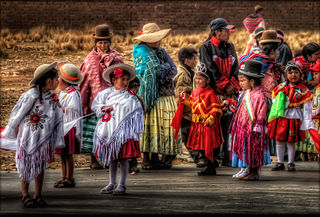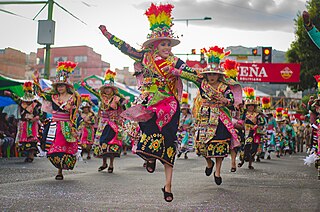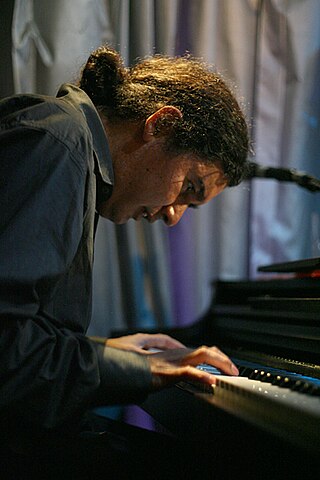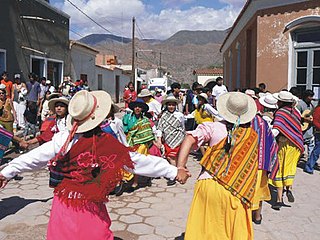Related Research Articles

Andean music is a group of styles of music from the Andes region in South America.
The music of Bolivia has a long history. Out of all the Andean countries, Bolivia remains perhaps the most culturally linked to the indigenous peoples.
Chilean music refers to all kinds of music developed in Chile, or by Chileans in other countries, from the arrival of the Spanish conquistadors to the modern day. It also includes the native pre-Columbian music from what is today Chilean territory.
Los Jairas was a Bolivian folk music group that was active in the 1960s. Their work features the charango, a stringed instrument from Bolivia.

Bolivia is a country in South America, bordered by Brazil to the north and east, Paraguay and Argentina to the south, Chile to the west, and Peru to the west.
Afro-Peruvian music, or Música negra, is a type of Latin American music first developed in Peru by enslaved black people from West Africa, where it is known as Festejo. The genre is a mix of West African and Spanish music.

Tinku, a Bolivian Aymara tradition, began as a form of ritualistic combat. In the Quechua language, it means "meeting-encounter". During this ritual, men and women from different communities will meet and begin the festivities by dancing. The women will then form circles and begin chanting while the men proceed to fight each other; eventually the women will join in the fighting as well. Large tinkus are held in Potosí during the first few weeks of May.
Música criolla, creole music or canción criolla is a varied genre of Peruvian music that exhibits influences from European, African and Andean music. The genre's name reflects the coastal culture of Peru, and the local evolution of the term criollo, a word originally denoting high-status people of full Spanish ancestry, into a more socially inclusive element of the nation.
The folkloric dance of the Tobas speaks of the ancient past of Bolivia. It has roots in a time when the Incas were the predominant force in the Andean highlands region. Tobas is an athletic dance comprising agile steps accentuated with many jumps and bounds.

The Caporales is a traditional Andean dance originated in Los Yungas of La Paz. Caporales were created and presented to the public for the first time in 1969 by the Estrada Pacheco brothers, who were inspired in the character of the 'Caporal' who is the overseer of the black slaves and was usually mixed race, wore boots and held a whip, a dance that belongs to the region of the Yungas, Bolivia The dance, however, has a prominent religious aspect. One supposedly dances for the Virgin of Socavón and promises to dance for three years of one's life. Caporal or caporales today is a folklore dance very popular in the festivities of not only Bolivia, but also Argentina, Chile, Peru, Spain and the United States.

The Carnival of Oruro is a religious and cultural festival in Oruro, Bolivia. It has been celebrated since the 18th century. Originally an indigenous festival, the celebration later was transformed to incorporate a Christian ritual around the Virgin of Candelaria . The carnival is one of UNESCO's Masterpieces of the Oral and Intangible Heritage of Humanity.
The Morenada is an Andean folk dance whose origins are still under debate. This dance is practiced mainly in Bolivia as well as in Peru and in recent years with Bolivian immigration in Chile, Argentina and other countries.

Afro-Bolivians are Bolivian people of Sub-Saharan African heritage and therefore the descriptive "Afro-Bolivian" may refer to historical or cultural elements in Bolivia thought to emanate from their community. It can also refer to the combining of African and other cultural elements found in Bolivian society such as religion, music, language, the arts, and class culture. The Afro-Bolivians are recognized as one of the constituent ethnic groups of Bolivia by the country's government, and are ceremonially led by a king who traces his descent back to a line of monarchs that reigned in Africa during the medieval period. They numbered 23,000 according to the 2012 census.
Javier Parrado is a Bolivian classical composer, whose works have been performed in Europe, and Latin America.

Daniel Tinte is a pianist from Argentina.

The Diablada, also known as the Danza de los Diablos, is an Andean folk dance performed in the Altiplano region of South America, characterized by performers wearing masks and costumes representing the devil and other characters from pre-Columbian theology and mythology. combined with Spanish and Christian elements added during the colonial era. Many scholars have concluded that the dance is descended from the Llama llama dance in honor of the Uru god Tiw, and the Aymaran ritual to the demon Anchanchu, both originating in pre-Columbian Bolivia

The Carnavalito is a traditional indigenous dance from the Argentinian Altiplano and puna regions, usually performed during religious festivities. Its current form is an expression of a syncretism between Pre-Columbian and Spanish colonial culture. .
The Saya is a music and dance that originated in Los Yungas-Chicaloma Bolivia. The artform's name comes from the Kikongo term nsaya, which means communal work led by a singing voice, akin to a work song. The Saya's instrumentation and dance also reflects the influence of traditional Andean music.

Bolivians are people identified with the country of Bolivia. This connection may be residential, legal, historical or cultural. For most Bolivians, several of these connections exist and are collectively the source of their being Bolivian.
Bolivia Manta is a Bolivian group created in France in 1977 by Carlos and Julio Arguedas that performs traditional music of pre-Hispanic and contemporary music of the Andes, particularly that of the Aymara and Quechua-speaking people of Bolivia and also traditional music of peoples of Peru and Ecuador. Bolivia Manta albums are an encyclopedia of Andean folklore, these dances and songs are collected in different parts of Peru, Bolivia and Ecuador, and most tracks are authentic performances of traditional rural music. They perform their music on indigenous flutes, panpipes and drums, as well as stringed instruments introduced since the Spanish conquest. In 1981, the group was awarded the Académie Charles Cros Grand Prix for the album Winayataqui, and in 1985, they received a Laser d'or from the Académie du disque français for the album Pak'cha.